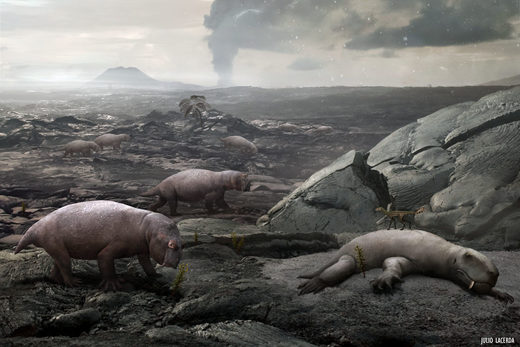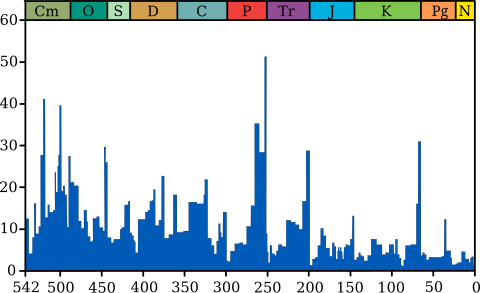| Topic: Earth's biggest mass extinction event - the methane hydrate | |
|---|---|

The Great Permian Extinction: The synapsid Lystrosaurus survived the extinction and dominated the landscape afterwards Abstract The cause for the end Permian mass extinction, the greatest challenge life on Earth faced in its geologic history, is still hotly debated by scientists. The most significant marker of this event is the negative δ13C shift and rebound recorded in marine carbonates with a duration ranging from 2,000 to 19,000 years depending on localities and sedimentation rates. Leading causes for the event are Siberian trap volcanism and the emission of greenhouse gases with consequent global warming. Measurements of gases vaulted in calcite of end Permian brachiopods and whole rock document significant differences in normal atmospheric equilibrium concentration in gases between modern and end Permian seawaters. The gas composition of the end Permian brachiopod-inclusions reflects dramatically higher seawater carbon dioxide and methane contents leading up to the biotic event. Initial global warming of 8-11 °C sourced by isotopically light carbon dioxide from volcanic emissions triggered the release of isotopically lighter methane from permafrost and shelf sediment methane hydrates. Consequently, the huge quantities of methane emitted into the atmosphere and the oceans accelerated global warming and marked the negative δ13C spike observed in marine carbonates, documenting the onset of the mass extinction period. The rapidity of the methane hydrate emission lasting from several years to thousands of years was tempered by the equally rapid oxidation of the atmospheric and oceanic methane that gradually reduced its warming potential but not before global warming had reached levels lethal to most life on land and in the oceans. Based on measurements of gases trapped in biogenic and abiogenic calcite, the release of methane (of ∼3-14% of total C stored) from permafrost and shelf sediment methane hydrate is deemed the ultimate source and cause for the dramatic life-changing global warming (GMAT > 34 °C) and oceanic negative-carbon isotope excursion observed at the end Permian. Global warming triggered by the massive release of carbon dioxide may be catastrophic, but the release of methane from hydrate may be apocalyptic. The end Permian holds an important lesson for humanity regarding the issue it faces today with greenhouse gas emissions, global warming, and climate change. http://www.sciencedirect.com/science/article/pii/S1871174X16300488 |
|
|
|
|
|
Odd how they didn't say the lava from the volcanism flooded salt traps, causing the greenhouse gases..
|
|
|
|
|
|
It's plausible.
And, having driven through Odessa at night, with the lovely aroma on the outskirts of town... I can believe a methane induced extinction occurred. Those damn prehistoric cattle ranchers. |
|
|
|
|
|
Oddesa, one of the loveliest spots in Texas...

|
|
|
|
|
|
I watched a program where fishermen were going into growing kelp to help replenish some of the damage they've done.
|
|
|
|
|
|
I watched a program where fishermen were going into growing kelp to help replenish some of the damage they've done. |
|
|
|
|
|
I think the Great Permian Extinction was a multiple condition extinction up to and including heavy Cosmic Ray Bursts or density of near interstellar space.
The P-Tr Extinction happened about a year ago (Galactic Year) which means we are now in the same general position in the galaxy. Since the galaxy is spiraling inward towards the center, not the exact same position. 
Millions of Years Extinction events have been slowly decreasing as the Sun gets closer and closer to the galactic core. The P-Tr event is the largest extinction event over the last two galactic years. It sticks out like a sore thumb. As the Sun moves closer to the galactic core it enters denser areas of galactic space. With this density, the Sun's heliopause shrinks, it compacts making it gain internal pressure. 225-250 mya the Sun was in a lesser dense area of the galaxy, the heliopause was extended and there was less protection from cosmic ray bursts. 
As the Sun plows thru interstellar space it causes a bow shock to form in front of it. The resistance of that bow shock determines the compaction of the heliosheath. One galactic year ago there was less resistance in the bow shock and the heliosheath was extended and sparse compared to now. More stuff got thru, less stuff being deflected, higher cosmic ray saturation. This explains the high rate of extinctions tapering off over time. The P-Tr event was a near burst that heated the Solar System causing multiple reactions on Earth. The Local Arm (Orion Arm) is colliding/merging with the Sagittarius Arm from the Perseus Arm. We are still in an area of sparse interstellar space compared to the density of space when we meet up with the Sagittarius Arm. Space is also slowly getting hotter as we get closer to the galactic core. 
I'm not saying this caused the P-Tr extinction but it probably contributed to it. A GRB (Gamma Ray Burst) does explain the high spike in the extinction events timeline. |
|
|
|
|
|
I watched a program where fishermen were going into growing kelp to help replenish some of the damage they've done. I think the kelp changes the acidity of the water and makes it favorable to fish. They were also growing clams under the kelp. |
|
|
|
|
|
I watched a program where fishermen were going into growing kelp to help replenish some of the damage they've done. I think the kelp changes the acidity of the water and makes it favorable to fish. They were also growing clams under the kelp. |
|
|
|
|
|
I think the Great Permian Extinction was a multiple condition extinction up to and including heavy Cosmic Ray Bursts or density of near interstellar space. The P-Tr Extinction happened about a year ago (Galactic Year) which means we are now in the same general position in the galaxy. Since the galaxy is spiraling inward towards the center, not the exact same position. 
Millions of Years Extinction events have been slowly decreasing as the Sun gets closer and closer to the galactic core. The P-Tr event is the largest extinction event over the last two galactic years. It sticks out like a sore thumb. As the Sun moves closer to the galactic core it enters denser areas of galactic space. With this density, the Sun's heliopause shrinks, it compacts making it gain internal pressure. 225-250 mya the Sun was in a lesser dense area of the galaxy, the heliopause was extended and there was less protection from cosmic ray bursts. 
As the Sun plows thru interstellar space it causes a bow shock to form in front of it. The resistance of that bow shock determines the compaction of the heliosheath. One galactic year ago there was less resistance in the bow shock and the heliosheath was extended and sparse compared to now. More stuff got thru, less stuff being deflected, higher cosmic ray saturation. This explains the high rate of extinctions tapering off over time. The P-Tr event was a near burst that heated the Solar System causing multiple reactions on Earth. The Local Arm (Orion Arm) is colliding/merging with the Sagittarius Arm from the Perseus Arm. We are still in an area of sparse interstellar space compared to the density of space when we meet up with the Sagittarius Arm. Space is also slowly getting hotter as we get closer to the galactic core. 
I'm not saying this caused the P-Tr extinction but it probably contributed to it. A GRB (Gamma Ray Burst) does explain the high spike in the extinction events timeline. http://www.bbc.com/news/science-environment-21082617 |
|
|
|
|
|
The Sun doesn't just revolve around the Milky Way like a ball orbiting a ball. It has a wave action in its orbit.

As the sun orbits around the center of the Milky Way, it bobs up and down relative to the plane of the galactic disk. Every 64 million years, our solar system pops above the "northern" edge of the disk, exposing Earth to a barrage of dangerous cosmic rays that may be affecting biodiversity on the planet. Credit: Mikhail Medvedev, courtesy of Dimitra Atri As this motion happens, the Heliosheath expands and retracts as the interstellar winds increase and decrease. During periods when the Sun is in position within the center of the cycle the interstellar medium is 'thicker' causing the sheath to retract and have more 'pressure'. When the Sun enters into the less dense 'thinner' parts of the cycle, the sheath expands and has less 'pressure' allowing an increase of penetration of cosmic rays. There are gamma ray bursts and gamma jets all thru our galaxy. Interstellar space is filled with them. Only when there is a burst or jet close enough to the Sun to penetrate the heliosheath do we 'experience' its effects. In addition, the magnetosphere of the Earth adds an additional layer of protection. One of the reasons why interplanetary manned missions are so hazardous is because people would be traveling out away from the protection of the Earth's magnetosphere. The proximity of a GRB or the alignment of a gamma jet cuts thru the protection and affects life on the planet. The motion of the Sun and the occlusion of other bodies blocks the constant penetration. We move out of alignment or behind another star system or cloud. Likewise, we move into the path of a black hole gamma jet and open areas but its all dynamic and any condition changes fairly quickly. We don't get the full brunt of the exposure but the limited exposure can sometimes be strong enough to upset the balance of the delicate systems on Earth that allows life to flourish. |
|
|
|
|
|
The Sun doesn't just revolve around the Milky Way like a ball orbiting a ball. It has a wave action in its orbit. 
As the sun orbits around the center of the Milky Way, it bobs up and down relative to the plane of the galactic disk. Every 64 million years, our solar system pops above the "northern" edge of the disk, exposing Earth to a barrage of dangerous cosmic rays that may be affecting biodiversity on the planet. Credit: Mikhail Medvedev, courtesy of Dimitra Atri As this motion happens, the Heliosheath expands and retracts as the interstellar winds increase and decrease. During periods when the Sun is in position within the center of the cycle the interstellar medium is 'thicker' causing the sheath to retract and have more 'pressure'. When the Sun enters into the less dense 'thinner' parts of the cycle, the sheath expands and has less 'pressure' allowing an increase of penetration of cosmic rays. There are gamma ray bursts and gamma jets all thru our galaxy. Interstellar space is filled with them. Only when there is a burst or jet close enough to the Sun to penetrate the heliosheath do we 'experience' its effects. In addition, the magnetosphere of the Earth adds an additional layer of protection. One of the reasons why interplanetary manned missions are so hazardous is because people would be traveling out away from the protection of the Earth's magnetosphere. The proximity of a GRB or the alignment of a gamma jet cuts thru the protection and affects life on the planet. The motion of the Sun and the occlusion of other bodies blocks the constant penetration. We move out of alignment or behind another star system or cloud. Likewise, we move into the path of a black hole gamma jet and open areas but its all dynamic and any condition changes fairly quickly. We don't get the full brunt of the exposure but the limited exposure can sometimes be strong enough to upset the balance of the delicate systems on Earth that allows life to flourish. |
|
|
|
|
|
wonder why they have the arrow going backwards in that pic? 
LOL, I didn't even notice that...Good Eye! 
|
|
|
|
|
|
Edited by
mightymoe
on
Wed 07/25/18 03:54 PM
|
|

Deep inside Permian-Triassic rocks, Becker's team found soccer ball-shaped molecules called "fullerenes" (or "buckyballs") with traces of helium and argon gas trapped inside. The fullerenes held an unusual number of 3He and 36Ar atoms -- isotopes that are more common in space than on Earth. Something, like a comet or an asteroid, must have brought the fullerenes to our planet. Above: The carbon atoms in a fullerene molecule are arranged in a spherical pattern similar to a geodesic dome. (Geodesic domes were invented by Buckminster Fuller, hence the name of the molecules.) This shape allows the fullerenes to trap gases inside. Image courtesy Luann Becker. Becker's team had previously found such gas-bearing buckyballs in rock layers associated with two known impact events: the 65 million-year-old Cretaceous-Tertiary impact and the 1.8 billion-year-old Sudbury impact crater in Ontario, Canada. They also found fullerenes containing similar gases in some meteorites. Taken together, these clues make a compelling case that a space rock struck the Earth at the time of the Great Dying. But was an asteroid the killer, or merely an accomplice? Many scientists believe that life was already struggling when the putative space rock arrived. Our planet was in the throes of severe volcanism. In a region that is now called Siberia, 1.5 million cubic kilometers of lava flowed from an awesome fissure in the crust. (For comparison, Mt. St. Helens unleashed about one cubic kilometer of lava in 1980.) Such an eruption would have scorched vast expanses of land, clouded the atmosphere with dust, and released climate-altering greenhouse gases. The rest of the article is here |
|
|
|
|









